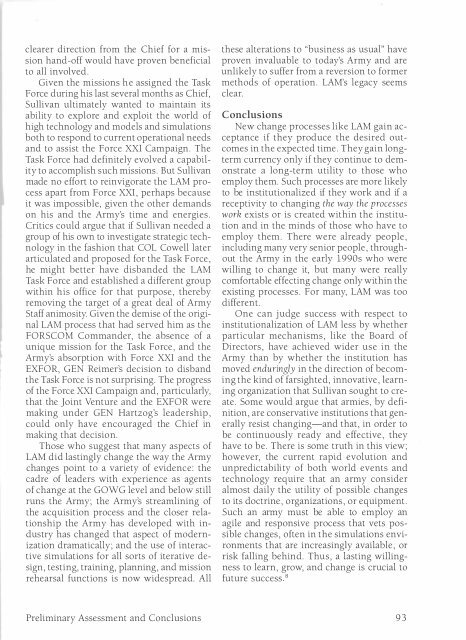The Modern Louisiana Maneuvers - US Army Center Of Military History
The Modern Louisiana Maneuvers - US Army Center Of Military History
The Modern Louisiana Maneuvers - US Army Center Of Military History
You also want an ePaper? Increase the reach of your titles
YUMPU automatically turns print PDFs into web optimized ePapers that Google loves.
clearer direction from the Chief for a mission<br />
hand-off would have proven beneficial<br />
to all involved.<br />
Given the missions he assigned the Task<br />
Force during his last several months as Chief,<br />
Sullivan ultimately wanted to maintain its<br />
ability to explore and exploit the world of<br />
high technology and models and simulations<br />
both to respond to current operational needs<br />
and to assist the Force XXI Campaign . <strong>The</strong><br />
Task Force had definitely evolved a capability<br />
to accomplish such missions. But Sullivan<br />
made no effort to reinvigorate the LAM process<br />
apart from Force XXI, perhaps because<br />
it was impossible, given the other demands<br />
on his and the <strong>Army</strong>'s time and energies.<br />
Critics could argue that if Sullivan needed a<br />
group of his own to investigate strategic technology<br />
in the fashion that COL Cowell later<br />
articulated and proposed for the Task Force,<br />
he might better have disbanded the LAM<br />
Task Force and established a different group<br />
within his office for that purpose, thereby<br />
removing the target of a great deal of <strong>Army</strong><br />
Staff animosity Given the demise of the original<br />
LAM process that had served him as the<br />
FORSCOM Commander, the absence of a<br />
unique mission for the Task Force, and the<br />
<strong>Army</strong>'s absorption with Force XXI and the<br />
EXFOR, GEN Reimer's decision to disband<br />
the Task Force is not surprising. <strong>The</strong> progress<br />
of the Force XXI Campaign and, particularly,<br />
that the Joint Venture and the EXFOR were<br />
making under GEN Hartzog's leadership,<br />
could only have encouraged the Chief in<br />
making that decision.<br />
Those who suggest that many aspects of<br />
LAM did lastingly change the way the <strong>Army</strong><br />
changes point to a variety of evidence: the<br />
cadre of leaders with experience as agents<br />
of change at the GOWG level and below still<br />
runs the <strong>Army</strong>; the <strong>Army</strong>'s streamlining of<br />
the acquisition process and the closer relationship<br />
the <strong>Army</strong> has developed with industry<br />
has changed that aspect of modernization<br />
dramatically; and the use of interactive<br />
simulations for all sorts of iterative design,<br />
testing, training, planning, and mission<br />
rehearsal functions is now widespread. All<br />
Preliminary Assessment and Conclusions<br />
these alterations to "business as usual" have<br />
proven invaluable to today's <strong>Army</strong> and are<br />
unlikely to suffer from a reversion to former<br />
methods of operation. LAM's legacy seems<br />
clear.<br />
Conclusions<br />
New change processes like LAM gain acceptance<br />
if they produce the desired outcomes<br />
in the expected time. <strong>The</strong>y gain longterm<br />
currency only if they continue to demonstrate<br />
a long-term utility to those who<br />
employ them. Such processes are more likely<br />
to be institutionalized if they work and if a<br />
receptivity to changing the way the processes<br />
work exists or is created within the institution<br />
and in the minds of those who have to<br />
employ them. <strong>The</strong>re were already people,<br />
including many very senior people, throughout<br />
the <strong>Army</strong> in the early 1990s who were<br />
willing to change it, but many were really<br />
comfortable effecting change only within the<br />
existing processes. For many, LAM was too<br />
different.<br />
One can judge success with respect to<br />
institutionalization of LAM less by whether<br />
particular mechanisms, like the Board of<br />
Directors, have achieved wider use in the<br />
<strong>Army</strong> than by whether the institution has<br />
moved enduringly in the direction of be coming<br />
the kind of farsighted, innovative, learning<br />
organization that Sullivan sought to create.<br />
Some would argue that armies, by definition,<br />
are conservative institutions that generally<br />
resist changing-and that, in order to<br />
be continuously ready and effective, they<br />
have to be. <strong>The</strong>re is some truth in this view;<br />
however, the current rapid evolution and<br />
unpredictability of both world events and<br />
technology require that an army consider<br />
almost daily the utility of possible changes<br />
to its doctrine, organizations, or equipment.<br />
Such an army must be able to employ an<br />
agile and responsive process that vets possible<br />
changes, often in the simulations environments<br />
that are increasingly available, or<br />
risk falling behind. Thus, a lasting willingness<br />
to learn, grow, and change is crucial to<br />
future success 8<br />
93
















